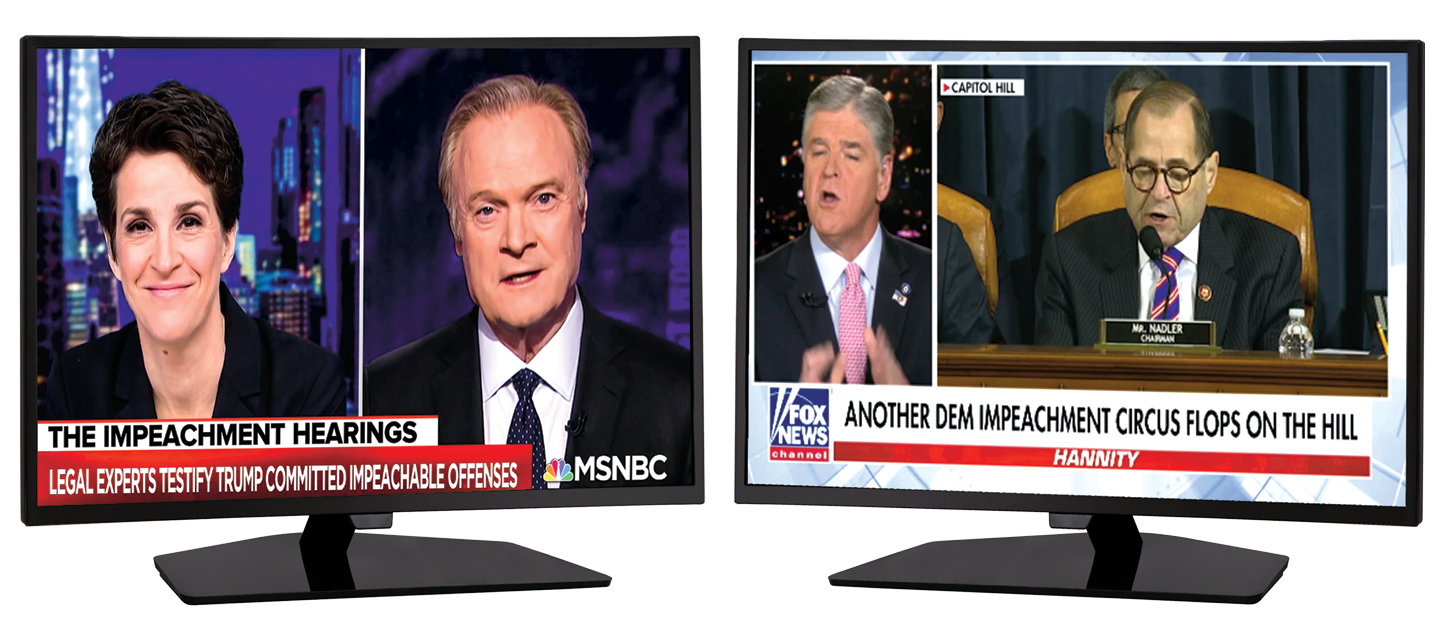For a glimpse at the country’s divided political reality, look no further than two television studios on opposite sides of Avenue of the Americas in midtown Manhattan.
From her set inside MSNBC headquarters, Rachel Maddow opened her prime-time coverage of the Trump impeachment hearings by calling the first day’s testimony “a double-barreled problem for the president—triple-barreled, maybe.” President Trump, she said, had been “caught doing something illegal” at the “direct expense of the country’s national interest.”
One block south, from a Fox News studio, Sean Hannity welcomed viewers by declaring “a great day for the United States, for the country, for the president—and a lousy day for the corrupt, do-nothing-for-three-years, radical, extreme, socialist Democrats and their top allies known as the media mob.”
These distinctly different visions—delivered simultaneously from skyscrapers roughly 1,000 feet apart—were beamed at the 9 p.m. hour into millions of American living rooms. It was a striking reflection of today’s choose-your-own-news media environment and a far cry from the era when Americans experienced major events through the same television lens.
Increasingly, viewers are flocking to opinionated news outlets with irreconcilable differences. Although every major TV station broadcast the Trump impeachment hearings live, Fox News (the channel favored by Trump supporters) and MSNBC (the channel most in sync with liberals) were far and away the most popular.
For a glimpse into the country’s divided political reality, look no further than two television studios. They sit on opposite sides of Avenue of the Americas in midtown Manhattan.
From her set inside MSNBC headquarters, Rachel Maddow covered the Trump impeachment hearings. She opened by calling the first day’s testimony “a double-barreled problem for the president—triple-barreled, maybe.” President Trump, she said, had been “caught doing something illegal.” And he did so, she continued, at the “direct expense of the country’s national interest.”
One block south, from a Fox News studio, Sean Hannity welcomed viewers. He declared it was “a great day for the United States, for the country, for the president—and a lousy day for the corrupt, do-nothing-for-three-years, radical, extreme, socialist Democrats and their top allies known as the media mob.”
These very different visions were delivered at the same time from skyscrapers roughly 1,000 feet apart. They were beamed at the 9 p.m. hour into millions of American living rooms. It was a striking reflection of today’s choose-your-own-news media environment. It’s a far cry from the era when Americans experienced major events through the same television lens.
Increasingly, viewers are flocking to opinionated news outlets with stark differences. Every major TV station broadcast the Trump impeachment hearings live. But Fox News (the channel favored by Trump supporters) and MSNBC (the channel most in sync with liberals) were by far the most popular.


